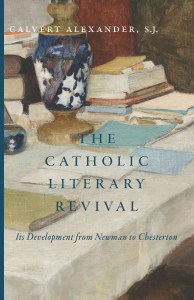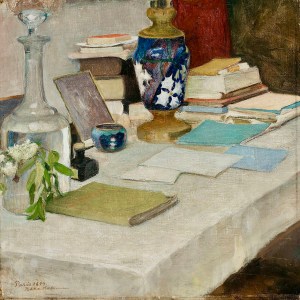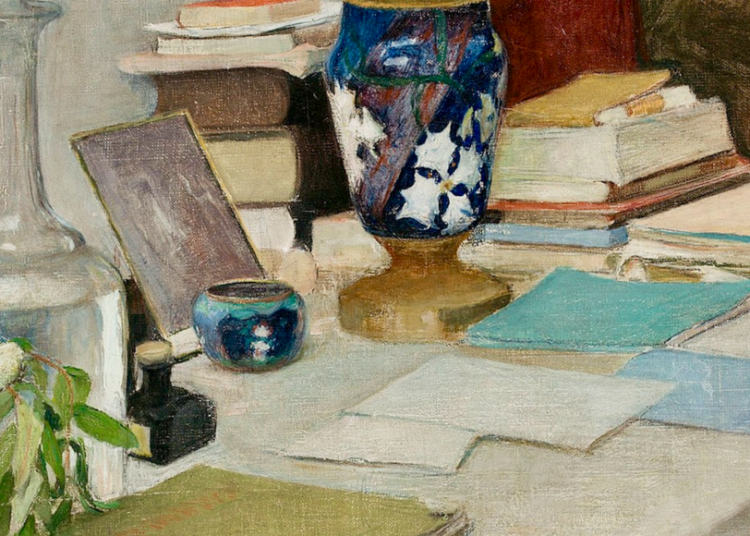Catholic literature, when we discover it coming into being in the mid-nineteenth century, is a literature of protest against the course being followed by European society. Its writers were not very numerous, nor did the typical Victorian man see any particular significance in their opposition to Liberalism, the anti-intellectual Romantic aesthetic, scientific naturalism, and the other institutions of a social order that seemed firmly established and destined to endure indefinitely.
The Catholic Literary Revival, by Calvert Alexander, S.J. (368 pages, Cluny Media)
 Although the “three phases” of modern Catholic literature we are about to consider cover the entire history of that literature, this volume is to be regarded as something less than a complete history of modern Catholic letters. It is an attempt rather to trace the development of Catholic literature through three successive and rather well-defined stages in its growth from the middle of the nineteenth century to the present day.
Although the “three phases” of modern Catholic literature we are about to consider cover the entire history of that literature, this volume is to be regarded as something less than a complete history of modern Catholic letters. It is an attempt rather to trace the development of Catholic literature through three successive and rather well-defined stages in its growth from the middle of the nineteenth century to the present day.
The partition of these approximately ninety years into three divisions is not an arbitrary one. The three phases (the first or Victorian phase from 1845 to 1890, the second or middle phase from the 1890s to the World War, and the third or contemporary phase from the World War to the present) will be found to correspond rather accurately with three generations of Catholic authors. They will be found to tie up even more accurately with the same number of stages in the cultural history of Europe, in as much as the decisive downward movement of that culture is reflected in the non-Catholic literature of English-speaking countries. The middle years of the nineteenth century, the 1890s, and the World War are each critical moments in the descending action of modern history; and they play no less significant a part in the rising action of the Catholic Revival. The numerous changes brought about in what we may call the non-Catholic world determine the characteristics taken on by Catholic literature in each of these phases. Moreover, they determine the position of importance or unimportance it holds in the eyes of men. Hence the necessity of understanding the relation between the Catholic Revival and the secular history with which it is everywhere in contact.
This relation is primarily one of revolt. Catholic literature, when we discover it coming into being in the mid-nineteenth century, is a literature of protest against the course being followed by European society. Its writers then were not very numerous, nor did the typical Victorian man see any particular significance in their opposition to Liberalism, the anti-intellectual Romantic aesthetic, scientific naturalism, and the other institutions of a social order that seemed firmly established and destined to endure indefinitely. The criticism advanced by men like Arnold or Ruskin against the mechanization of life would be understood and even accepted by some because it came from a philosophy that was a part of the world it essayed to criticize. But not so the fulminations of Newman and Patmore; the position from which they launched their anathemas seemed remote and very far away, either in the dead past or in the unborn future. Thus, too, a Catholic like Gerard Hopkins could write supreme lyric poetry in the nineteenth century which would not be recognized or even published until after the World War, and then it would be regarded as contemporary poetry. Catholic literature was dwarfed into insignificance by the towering prosperity and confidence of this bourgeois world against which it rebelled.
With the advent of the 1890s, however, a distinct turn for the better is observable. Alice Meynell, Lionel Johnson, Francis Thompson, and other Catholics who wrote during this period receive recognition and are even accorded a measure of leadership by those who are rapidly losing their faith in nineteenth century civilization. But that recognition is a restricted one. Catholic literature does not occupy a position of importance in the non-Catholic world until after the Great War, that is to say, in the third of the three phases.
This phase goes under the name of “post-war,” although it has been evident for some time that the term has ceased to mean anything in modern literature. It was invented by that elder generation of Liberals that caused the war to designate the unsteady state of soul of the generation that had borne the brunt of it. And it was full of hope. The hope was that all these manifestations of a youthful sickness and rebellion were temporary; they would pass and men would return again to the buoyant, confident rhythm of pre-war days. That war generation, the object of so much solicitude, is today no longer young. It talks of returning to many strange things, to the Elizabethans, to the philosophy of Aquinas, to the classics, to monarchy, to baroque mysticism, to a healthy barbarism—but not to democratic Liberalism, nor to the promises of Science and Progress, nor to the parousia of Big Business and Industrialism, nor to reverent Rationalism, nor to charming bourgeois letters, nor to any of the other happy institutions and splendid ideologies of the society into which its members were born.
There survive, of course, not a few who still hold on to the externals of this old order, the majority because of the binding force of established conventions, but some because they sincerely believe in it. These latter are for the most part old men, grandfathers some of them, who committed themselves in the nineteenth century of their youth to bad guesses, already in those days prosperous conventions. They do not understand the pronounced impiety of the younger generation. They still diagnose it as a post-war malady and think, like H. G. Wells, that they may tease the young man out of his sickness by dangling before his tired eyes bigger and better promises and all the shining mechanical toys of the world to come.
But the sickness is not a heritage of the World War. It is the heavy sense of being wholly without a heritage that sickens him, of being obliged to face the uncertainties of the future with empty hands because he has been bequeathed nothing worthy of transmission, nothing but “the accumulated rubbish of three centuries of cracked-brain revolt and faded dreams.” Not even the impious joy of turning upon this old world of his fathers and rending it is now left him; for that also today has taken on many of the futile characteristics of beating a dead horse.
For the majority of these “post-war” writers whom the years have made mature and thoughtful, and for many older ones too, there is no longer any question of bemoaning the passage of this order or of celebrating the magnificence of its demise.
This is the way the world ends,
This is the way the world ends,
Not with a bang but with a whimper,
sings T. S. Eliot. They accept the fact, evident enough in itself and confirmed by the mass of evidence patiently collected and arranged by such philosophers and critics of culture as Oswald Spengler, Nicholas Berdyaev, Christopher Dawson, Wyndham Lewis, and others. They are already concerned with the problems of a new world which they see emerging “from the obscure chrysalis of history.”
 The choice of the modern man in this new world, says J. Middleton Murry, lies between Communism and Catholicism; he chooses Communism. The Russian Nicholas Berdyaev sees the choice as between a militant Catholicism and a militant atheism, between Christ and anti-Christ, and he chooses Catholicism. Evelyn Waugh, whose accession to the leadership of London’s young intelligentsia has given rise to the “pre-Waugh and post-Waugh” designation of the new alignments, announced in 1930 when he was received into the Church that the modern artist must make a brave and disjunctive choice between Rome and Moscow. In America, Eugene O’Neill has recently fixed the points of the modern dilemma even more sharply in his play Days Without End; the choice, as he sees it, seems to lie between the Catholic Church and suicide. Even those who do not admit that “the hour of decision” is immediately at hand, see the dilemma in much the same terms. Thus the late Irving Babbitt:
The choice of the modern man in this new world, says J. Middleton Murry, lies between Communism and Catholicism; he chooses Communism. The Russian Nicholas Berdyaev sees the choice as between a militant Catholicism and a militant atheism, between Christ and anti-Christ, and he chooses Catholicism. Evelyn Waugh, whose accession to the leadership of London’s young intelligentsia has given rise to the “pre-Waugh and post-Waugh” designation of the new alignments, announced in 1930 when he was received into the Church that the modern artist must make a brave and disjunctive choice between Rome and Moscow. In America, Eugene O’Neill has recently fixed the points of the modern dilemma even more sharply in his play Days Without End; the choice, as he sees it, seems to lie between the Catholic Church and suicide. Even those who do not admit that “the hour of decision” is immediately at hand, see the dilemma in much the same terms. Thus the late Irving Babbitt:
The choice to which the modern man will finally be reduced, it has been said, is that of being a Bolshevist or a Jesuit. In that case (assuming that by a Jesuit is meant the Ultra-montane Catholic) there does not seem to be much room for hesitation. Ultra-montane Catholicism does not, like Bolshevism, strike at the very roots of civilization. In fact, under certain conditions that are already partly in sight, the Catholic Church may perhaps be the only institution left in the Occident that can be counted upon to uphold civilized standards.
In this third or “post-war” phase of the Catholic revival, then, we discover the Catholic Church firmly established in the modern consciousness as one of the alternatives which the modern artist recognizes he must choose between. We may assert, as we shall, that this same dilemma existed in the middle of the nineteenth century. But we should find difficulty in showing that any, except a very few, recognized it in these present terms. Catholicism in those days was not a recognized choice for the modern artist. It was considered the choice of the illiberal, the mentally warped, of him who loved the darkness better than the light. In other words, it was no choice at all.
This essay is the first part of the Introduction to The Catholic Literary Revival.
Republished with gracious permission from Cluny Media.
Imaginative Conservative readers may use the code IMCON15 to receive 15% off any order of not-already discounted books from Cluny Media.
The Imaginative Conservative applies the principle of appreciation to the discussion of culture and politics—we approach dialogue with magnanimity rather than with mere civility. Will you help us remain a refreshing oasis in the increasingly contentious arena of modern discourse? Please consider donating now.
The featured image is “Still Life” (1894) by Pekka Halonen, and is in the public domain, courtesy of Wikimedia Commons.


